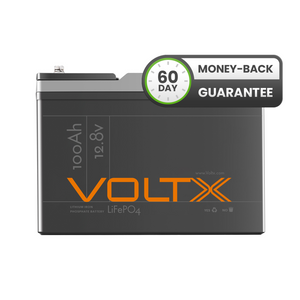AGM (Absorbed Glass Mat) batteries, designed originally for the military, came into wide use in the 1980s. Used in military aircraft, heavy-duty vehicles, and UPS, among other applications, they are lighter and more reliable, and able to withstand more punishing use. In an AGM battery, the electrolyte is held next to the plates in thin fiberglass mats, instead of freely flooding the plates. This construction gives them some advantages over traditional, flooded, Sealed Lead Acid batteries.
Pros of Power AGM Batteries
They can withstand colder temperatures than a typical wet cell battery. If they are frozen, even though they won 't operate, they are not damaged.
They can be installed in any orientation.
They are spill-proof. Because the acid is held in the fiberglass mats, they won 't spill, even if they are broken. They are safe to transport and are exempt from hazardous materials restrictions.
They are vibration-resistant. They were designed to withstand the constant vibration of military airplanes and helicopters.
They are shock-resistant.
They produce minimal gassing, so they can be used in less well-ventilated areas.
They have a low self-discharge rate, meaning they can be stored for longer before they require a charge.
If well maintained, they last longer than SLA batteries.
They require no maintenance.
Cons of Power AGM Batteries
Manufacturing costs are higher, making the batteries more expensive.
Some older battery testers can 't accurately test AGM batteries.
AGM batteries are well designed, reliable, and durable power sources for applications where their advantages outweigh their disadvantages.
They require a charger specifically for AGM batteries that monitors volts, amps, and ambient temperatures.
More batteries are moving into the trunks and under the seats of some vehicles. If the battery is not under the hood, chances are it 's an absorbent glass mat (AGM) or gel cell battery. AGM batteries eliminate acid spilling in accidents because they are sealed. They can also be installed at odd angles.
Manufacturers can shave off a few pounds from the vehicle because these batteries pack a lot of power for their size and weight. That 's a big reason why they are being found more and more on late-model vehicles.
Top 3 misconceptions about power AGM batteries:
You can use your regular battery charger on AGM or gel cell batteries.
Not true. These batteries like to be charged slow and low. Many AGM/gel cell battery chargers have microprocessors that collect information from the battery and adjust the current and voltage accordingly. Some have different settings for charging flooded, gel, and AGM batteries. Overcharging can kill these batteries. Also, alternators are not chargers. Don 't rely on an alternator to do the work of a charger. If a battery is discharged to the point that it cannot start the vehicle, use a charger as soon as possible to make sure the battery gets fully charged.
AGMs and gel cells can be tested the same way as conventional batteries.
Not true. These types of batteries have lower internal resistance than flooded batteries. Older capacitance battery testers/analyzers may not be able to accurately read these batteries. Most new battery analyzers have a special mode for AGM/gel cell batteries. Old-school load testers might not provide conclusive results.
AGM or gel cell battery replacement is the same as flooded battery replacement.
Both true and untrue. While the installation of the battery may be the same for the two battery styles, some vehicles require an extra step to tell the vehicle that the battery has been replaced. Newer vehicles have a Battery Sensor Module or similar systems. These systems require recalibration with a scan tool if the battery is replaced. If the system is not recalibrated, the alternator might overcharge the new battery and cause the battery to fail soon after replacement.


